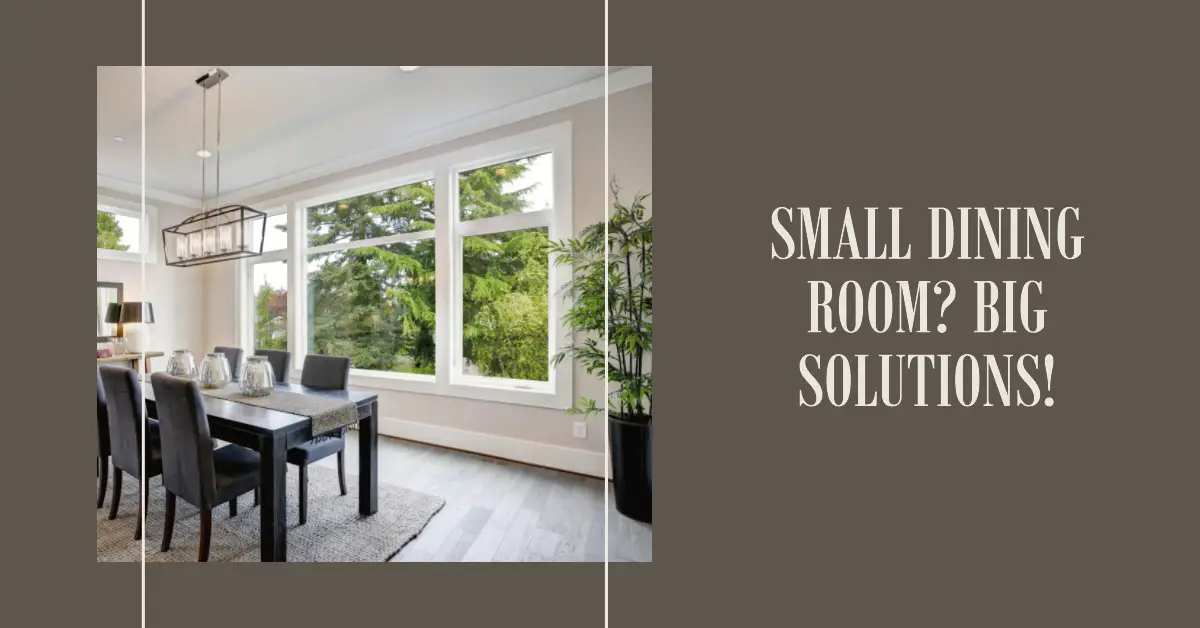I am a well-rounded expert with proficiency in several fields. My experience spans from being a dedicated chef and homemaker. As a passionate homesteader, I’ve honed my skills in sustainable living and animal care, ensuring a holistic approach to everything I undertake. Email me or Txt: (# removed due to spam, please email)
Decorating a small dining room can seem like a daunting task, but fear not! With clever tactics and thoughtful approaches, you can easily create a spacious illusion within a limited area.
Join us as we explore a treasure trove of expert tips and strategies to help you make the most of your petite dining room. We’ll delve into color selection, furniture choices, optimizing natural and artificial lighting, strategic space planning, the art of mirror placement, and more!.
Let’s embark on this journey together and transform your small dining space into an inviting and stylish haven.

Color Palette Selection
When selecting a color palette for a small dining room, it’s important to keep in mind the effect that different colors can have on the perceived size of the space.
Lighter colors, such as white, cream, and pastels, can create the illusion of a more open and airy space. These colors reflect light, which can make a small room feel larger.
A monochromatic color scheme, which uses different shades and tints of the same color, can also be effective in making a small dining room look bigger.
This approach creates a cohesive and consistent look, which can help to visually expand the space. Using a neutral color, such as beige or gray, as the base color can also help to create a sense of calm and balance in a small dining room.
While light and neutral colors are often the go-to choice for small spaces, adding pops of color strategically can add interest and personality without overwhelming the space.
Consider incorporating a bold accent wall, colorful artwork, or decorative accessories in a bright hue to add visual interest and depth to your small dining room.
However, it’s important to use these pops of color sparingly and in a way that complements the overall color scheme of the room.
Remember, the key to selecting the right color palette for a small dining room is to create a sense of openness and harmony.
By using light and neutral colors as the base, incorporating pops of color strategically, and maintaining consistency throughout the space, you can create a dining room that feels spacious and inviting, no matter its size.

Optimal Furniture Choices
When it comes to furnishing a small dining room, selecting the right furniture is key. Opting for multipurpose and space-saving pieces, such as foldable tables and chairs, can help maximize the available space without sacrificing functionality.
It’s also important to consider the scale and proportion of the furniture, as oversized pieces can make a small room feel even smaller.
One great option for a small dining room is a round table. Not only do they offer a more intimate dining experience, but they also enhance flow and openness in the space.
Round tables take up less visual space and can help create a more natural flow, making the room feel larger and more inviting.
When selecting chairs to accompany your round table, consider using armless chairs, as they take up less space and can easily be tucked underneath the table when not in use. It also makes it easier for guests of all shapes and sizes sit comfortably.
In addition to space-saving furniture, consider using built-in furniture or storage solutions to make the most of your small dining room.
For example, installing built-in shelves or a banquette seating area can provide additional storage and seating options without taking up valuable floor space.
By choosing furniture that is both functional and visually appealing, you can create a welcoming and comfortable dining space, even in a small room.

Maximizing Natural Light
Natural light is important in small spaces, as it can make the room feel more open and spacious.
Window treatments that allow light in, such as sheer curtains or blinds, are essential. Reflective surfaces, such as mirrors or shiny surfaces, can enhance natural light.
Additionally, consider using light-colored or sheer fabrics for your window treatments, as they can help diffuse the light and create a soft, airy feel in your dining room.
Another way to maximize natural light is to avoid blocking windows with furniture or décor. If possible, position your dining table near a window to take advantage of natural light during meal times.
Remember, Light plays a big roll in how we perceive the rooms we are in.

Effective Lighting Solutions
Layered lighting, such as pendant lights and wall sconces, can add depth and dimension to the room. Pendant lights can be a great option for small dining rooms, as they can provide overhead lighting without taking up much space.
Additionally, wall sconces can provide a warm and cozy ambiance and can be installed on the walls to free up valuable floor space.
Another important consideration is the use of dimmer switches. Dimmers allow for greater control over the lighting atmosphere and can create a cozy and intimate ambiance for dinner parties or family gatherings.
Choosing light fixtures that are proportional to the size of the room is crucial for achieving the optimal lighting balance. Oversized or undersized fixtures can disrupt the visual harmony of the room and make the space feel cramped or empty.
When choosing lighting solutions for a small dining room, it’s important to consider the location and placement of each fixture. Placing lights strategically, such as over the dining table or in corners of the room, can help to create focal points and enhance the natural flow of the space.
Choosing light fixtures that have a reflective surface, such as metallic or glass, can help to amplify the effect of natural light and make the room feel brighter and more spacious.
Finding the right lighting solutions is key to creating an inviting and functional small dining room.
Careful consideration of the location, placement, and proportion of each fixture, as well as the use of dimmer switches and reflective surfaces, can help to maximize the space and create a warm and welcoming atmosphere.

Smart Space Planning
One effective strategy is to use flexible seating options that can be easily rearranged to accommodate different group sizes.
For example, benches or stools can be tucked away when not in use, but easily pulled out when needed for extra seating.
Creating focal points is another smart space planning technique that can add interest and style to a small dining room.
By using artwork, decorative lighting fixtures, or other eye-catching elements, you can draw the eye and create a sense of visual depth. This can help make the space feel more dynamic and engaging.
Utilizing vertical space is also important when planning a small dining room. This can involve adding shelving or storage units that take advantage of the full height of the room, or incorporating hanging elements such as plants or artwork.
By using the space above eye level, you can create the illusion of a larger and more expansive room.
Another important aspect of smart space planning is to ensure that the flow of the room is optimized for maximum efficiency and ease of use.
This can involve strategically placing furniture to create clear pathways, or using a round table to facilitate easy movement around the space. By considering the needs and habits of those who will be using the dining room, you can create a space that is both functional and aesthetically pleasing.

Mirror Magic
Mirrors can be an effective tool to make a small dining room look bigger by reflecting light and creating the illusion of more space. When using mirrors, it’s important to consider their placement and size carefully.
Placing a mirror across from a window can help reflect natural light and make the room feel brighter and more open.
Placing a mirror on a focal wall can create a striking visual effect and draw attention to the mirror and the surrounding décor.
The size and style of the mirror should also be taken into consideration. Choosing a large mirror can make the room feel more expansive, while a small mirror may not have the same impact.
Selecting a frame that complements the style of the room can enhance the overall aesthetic.
A frameless mirror, for example, can create a sleek and modern look, while a ornately framed mirror can add a touch of elegance and sophistication.

Visual Tricks with Flooring and Rugs
Diagonal or striped patterns can elongate a small dining room space. Selecting the right rug size for your dining area is also important, as a rug that is too small can make the space feel cramped.
Continuity of flooring throughout the space can also create an expansive feel.
In addition to patterns, flooring and rugs can also create visual tricks to make a small dining room feel bigger.
Choosing light-colored flooring, such as pale wood or light-colored tile, can help reflect light and make the room feel brighter and more spacious.
Placing a rug under the dining table can anchor the space and add warmth, but be sure to choose a size that fits the dining area appropriately.
A rug that is too small can make the space feel disjointed and crowded. Additionally, selecting a rug with a pattern or texture can add interest and depth to the room.
Finally, maintaining continuity of flooring throughout the space can create a seamless flow and make the dining room feel more spacious.

Wall Décor and Artwork
Wall décor and artwork are essential elements in decorating a small dining room. Large-scale artwork can create a focal point and add depth and interest to the room.
Gallery walls are another popular option, allowing for the display of multiple pieces of art in a cohesive arrangement.
Minimalist wall décor, such as a single statement piece or a few small framed photos, can also help create a spacious feel by avoiding clutter.
When selecting wall décor and artwork, consider the color scheme and style of the room.
Artwork with bright colors or bold patterns can add visual interest, while monochromatic or neutral artwork can create a sense of consistency.
When hanging artwork or creating a gallery wall, consider the height and placement of the pieces.
Hanging artwork at eye level or slightly above can create the illusion of a taller ceiling, while placing smaller pieces closer together can make the wall appear larger.
It’s also important to balance the weight and size of each piece to create a cohesive arrangement.

Tips for Decluttering and Organization
Decluttering and organization are essential in small dining rooms to maintain a spacious feel.
Storage solutions for dining room essentials, such as tableware or linens, can be incorporated into furniture or shelving.
Regular decluttering habits can also help maintain a spacious feel. A cluttered full room is always going to feel small.

Conclusion
Maximizing a small dining room space requires strategic planning and attention to detail. By following these expert tips and strategies for color selection, furniture choices, lighting, space planning, mirror placement, flooring and rug selection, wall décor, and organization, you can create the illusion of a larger space and enjoy your dining room to its fullest potential.



